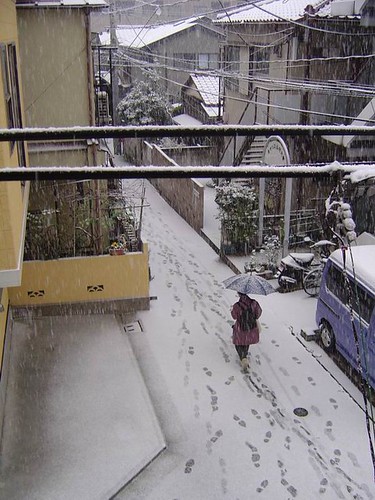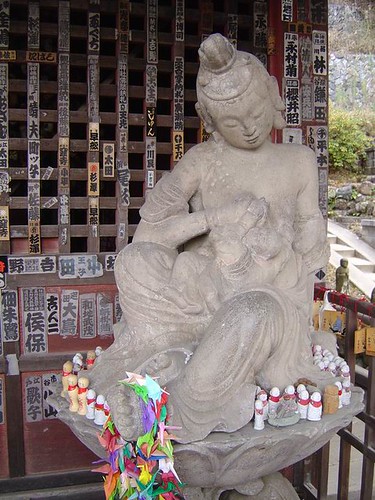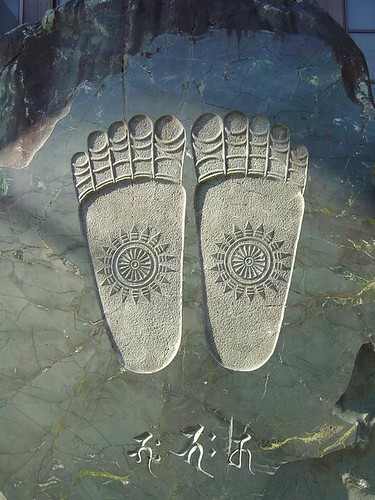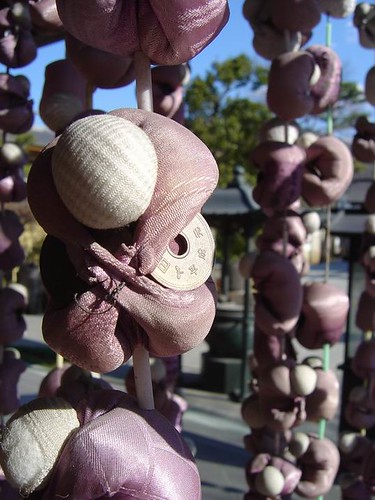
The snow was deep yesterday. Thought I'd write about my Christmas trip to the mountains.
Mizuki and I took an early express train to Chichibu on the morning of the 24th. Chichibu is a town in western Saitama prefecture, about 1.5 hours north-westish of Tokyo. Saitama is often known as "the New Jersey of Japan." It's close to a great city. It's a suburban commuter area. And it's profoundly unfashionable. Adding the syllable Da- to its name gives you Dasai-tama, or Unfashionable Ball. Don't ever mention this to people who live there, though. The only cool thing about Saitama is the Saitama Super Arena, where major sporting events are held (including the year-ending Otoko Matsuri (Man Festival) on Dec. 31 where lots of big scary dudes from around the world beat the living bejeezus out of eachother in a square-shaped ring. Oh yeah and the Urawa Reds, who are apparently a good football team (don't ask me; I just teach them English.)
So anyway, we went Inaka (Beyond the Black Stump.) Out in the sticks in the uncoolest place in the country. Why, you may ask? Why oh why oh why?
Two reasons, and good ones:
God and Hot Springs.
Goddess in fact. In Chichibu there are a series of 34 temples dedicated to the Buddhist deity Kannon (Kwan Yin in Mandarin Chinese.) There used to be 33, which is a holy number, the soul spending 33 years in limbo before transmigrating to a new incarnation, but then this group hooked up with two others (in Kyoto and Wakayama, I believe) and added an extra to give a total of 100. Thems a lotta temples. Kannon is a Bodhisattva, an enlightened soul who has forgone the bliss of ascending to nirvana in order to help all other souls find their way thenceward. She is the goddess of Mercy and Childbirth. One of the temples we visited (perhaps number 6 or 7; I can't recall) actually has a strikingly out-of-place and Madonna-like statue of her holding a small child to her breast. It is thought that this statue, donated by a rich noble in the Edo period, was secretly crafted by an underground Christian group and surrepetitiously 'smuggled in.' Christianity was outlawed by the Shogunate of the time. Kannon is quite beautiful. She has a serene face, and sad eyes, filled with compassion for the sufferings of the world. But my deepest and most lasting impression of Kannon comes from the Sakai Masaaki TV show from the 70s: Monkey! She saves his hairy pink ass on many an occasion.

So we hiked around to all these temples, and our feet got REALLY sore. Up mountains and down valleys, past schoolyards and cement factories, disused warehouses, quaint cottages, gutters full of toxic slime, railyards, traditional inns, decorative glass-blowing manufacturers, five hundred year-old olive trees, maples, a forest of cedars and soba restaurant after soba restaurant (a local specialty, apparently.) At each temple we entered, we stopped to make an small offering and a prayer, surveyed the grounds and architecture, then had a chat with the monk on duty. While we talked he would, in beautiful ink-brush calligraphy, inscribe our books with the temple name, date, and a poem.

The days were short, so we retired early as soon as the sun dropped behind the looming peaks to the west. And then onto the onsennatural hot springs, the only other reason to come to Chichibu in winter. The hot springs were hot and springy, which is to say, just the way they're supposed to be. Which is a good thing. Really. And anyway, greatly relaxing after a day-long pilgrimage in the freezing December air. Scalding hot milky white water and steam so thick it feels like you're drinking when you breathe. We had roast chicken and salad and vodka for Christmas dinner (no turkeys out in rural Japan I'm afraid,) surveying the mountains and icy river below our hilltop ryokan inn.

One last thing about this town. It is dominated by a mountain. Buko-san. Quite an impressive monster. It looms so hugely on the sky that you cannot help but feel its presence at all times. It casts a long shadow over the valley. In times past the people of the Chichibu valley had two major gods: the god of the mountain, a male spirit; and the god of the dark wood in the center of the valley, a female deity. At the famous Yomatsuri (Night Festival) on Dec. 2nd each year the god of Buko-san would descend from his mountain seat in the form of the head priest's ceremonial staff, make a procession to the shrine in the center of the sacred wood, and meet his bride. The staff would be ritually placed in a hollow on the back of a turtle-statue to complete the symbolic union. This ritual continues to be practiced today, and the staff and the turtle are still there.
However....
Buko-san is destroyed. After the 2nd World War Chichibu, like all small communities in Japan, was pressed to find some kind of industry to help the economic recovery of the nation. It was found that Buko-san, the seat of the god, was largely made from limestone and stone perfect for the manufacture of cement, so prized by the state-supported (to this day) construction industry. So the mountain was cut down. I shit you not. I have never seen anything like it before in my life. Somewhere between a quarter and a third of the top of the mountain is gone. Just cut out. The scar is quite plain to see. Most of the mountain is stripped bare of trees. Great tiers of grey stone can be seen from tens of kilometres away. It is a vast ugliness, a scar beyond reckoning.
So the question I have is: how does this psychologically affect the people who live in the shadow of this mountain, their own god whom they ravaged and destroyed in the name of industrialization? Every day, every minute, the corpse of this decapitated god looms on the edge of the valley, his body broken and torn. Shinto is a religion deeply connected with nature, and the Japanese people will tell you that they are deeply respectful of the gods of the natural world. I fear the shadow that lies over this valley. The murder of a god is not without consequences.

No comments:
Post a Comment